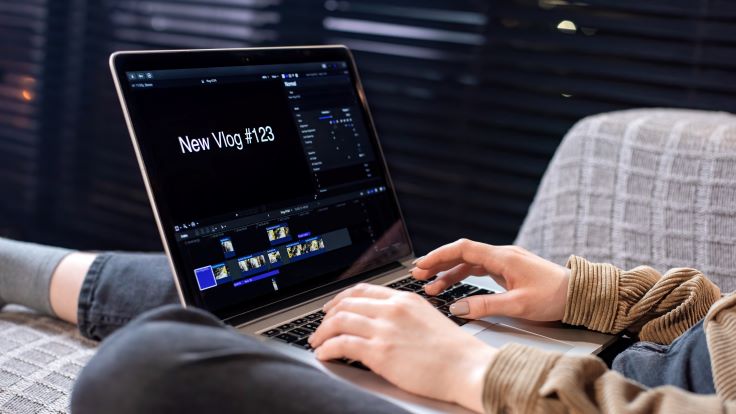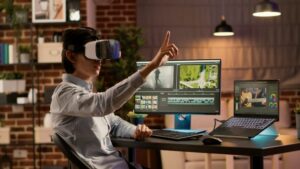“We need Storytelling. Otherwise, life just goes on and on like the number Pi.” – Ang Lee
In the world of film and video design, technology has been a driving force behind numerous advancements and innovations. From the early days of silent films to the present era of high-definition digital cinematography, technology has transformed the way stories are told and visualized on the screen. The impact of technology on film and video design can be seen in various aspects, including visual effects, virtual reality, and the overall filmmaking process.
One of the most significant impacts of technology on film and video design is the advent of visual effects (VFX). VFX has revolutionized the film industry by allowing filmmakers to create stunning and realistic environments, creatures, and events that were previously impossible to capture on camera. With the help of computer-generated imagery (CGI), filmmakers can bring fantastical worlds to life, transport viewers to different periods, and showcase larger-than-life action sequences. Films like “Avatar,” “The Lord of the Rings” trilogy, and “The Avengers” series have pushed the boundaries of what is visually achievable, captivating audiences worldwide. Technology has made it possible to seamlessly blend real footage with computer-generated elements, enhancing the overall cinematic experience
Another area where technology has made a profound impact is in the realm of virtual reality (VR) and augmented reality (AR). VR allows users to immerse themselves in a fully digital environment, while AR overlays digital information in the real world. These technologies have opened up new avenues for storytelling and audience engagement. Filmmakers and video designers can now create interactive experiences that blur the line between fiction and reality. VR and AR have found applications not only in film and video games but also in other industries such as education, marketing, and training. The ability to transport viewers into virtual worlds and provide them with interactive narratives has transformed the way stories are experienced and consumed.
Furthermore, technology has greatly influenced the filmmaking process itself. Digital cameras have replaced traditional film cameras, offering higher resolution, better low-light performance, and greater flexibility in post-production. Digital cinematography has made it easier and more cost-effective for filmmakers to experiment with different shots, angles, and lighting setups. The advent of high-definition cameras and streaming services has also led to an increase in the production of online video content. Platforms like YouTube, Netflix, and Amazon Prime have allowed aspiring filmmakers and content creators to showcase their work to a global audience, bypassing traditional distribution channels.
In addition to the production process, technology has significantly impacted the post-production phase of filmmaking. Non-linear editing systems have replaced traditional linear editing methods, allowing editors to manipulate footage with greater precision and efficiency. Specialized software and tools have been developed to enhance color grading, sound design, and visual effects compositing. These advancements have not only made the post-production process more streamlined but have also democratized access to professional-grade editing tools. Filmmakers and video designers can now achieve high-quality results without the need for expensive equipment or studio facilities.
The impact of technology on film and video design extends beyond the creative aspects and into the distribution and consumption of content. The rise of streaming platforms has changed the way films and videos are distributed and accessed by audiences. Viewers can now watch their favorite movies and TV shows on demand, anytime and anywhere, thanks to platforms like Netflix, Hulu, and Disney+. This shift in distribution has challenged the traditional cinema experience, leading to a debate about the future of movie theaters. However, technology has also presented new opportunities for filmmakers to reach a wider audience through online platforms, social media, and viral marketing campaigns.
While technology has undoubtedly revolutionized film and video design, it is essential to recognize that it is a tool that should serve the creative vision rather than overshadow it. As technology continues to evolve, filmmakers and video designers must strike a balance between embracing technological advancements and maintaining the integrity of storytelling and artistic expression.
Filmmakers and video designers need to understand that technology is not a substitute for compelling narratives, well-developed characters, and strong visual storytelling. Technology should enhance and support the creative vision, enabling filmmakers to bring their ideas to life in ways that were previously unimaginable. It is the combination of technical expertise and artistic vision that ultimately creates a captivating and immersive cinematic experience.
Moreover, while technology has made filmmaking more accessible and democratized the industry to some extent, it has also created new challenges. With the proliferation of affordable equipment and online platforms, the market has become saturated with content. Standing out in this crowded landscape requires not only technical proficiency but also originality, creativity, and a deep understanding of storytelling principles. The impact of technology on film and video design should not overshadow the importance of honing one’s craft, studying the art of filmmaking, and continuously pushing the boundaries of creativity.
Furthermore, it is crucial to acknowledge the potential ethical implications of technological advancements in film and video design. Deepfake technology, for example, has raised concerns about the authenticity and integrity of visual content. As technology becomes more sophisticated, filmmakers and video designers need to use these tools responsibly and ethically, avoiding misinformation, manipulation, and the erosion of trust.
In conclusion, the impact of technology on film and video design has been transformative, revolutionizing the way stories are told, visualized, and consumed. Visual effects, virtual reality, digital cinematography, and post-production tools have expanded the possibilities for creativity and immersion. Streaming platforms have changed the distribution landscape, while social media and online platforms have provided avenues for independent filmmakers to showcase their work. However, amidst all these advancements, filmmakers and video designers must maintain a balance, using technology as a tool to enhance storytelling rather than overshadow it. The fusion of technological innovation and artistic expression is what truly drives the evolution of film and video design, captivating audiences and pushing the boundaries of creativity.


